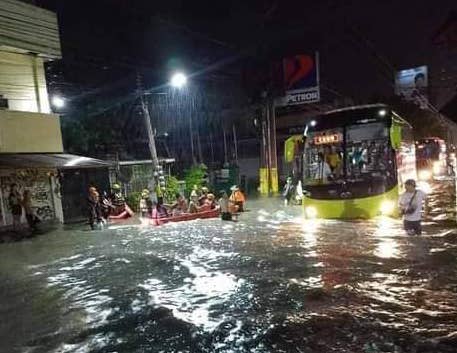
This 2022 photo shows a flooded Cebu City street after a heavy downpour | photo from Cebu City PIO
CEBU CITY, Philippines – The severe flooding in Luzon, driven by the combined forces of Super Typhoon Carina and the southwest monsoon, has pushed local government units (LGUs) to reassess their drainage systems.
In Cebu City, even moderate rain and wind can result in flooding in the downtown area and other parts of the city.
If Cebu faced similar climate disasters, would we be ready to handle them?
“We are already doing a lot of things… It’s not an overnight solution. The volume of rain has tripled unya atong existing drainage system 90’s pa na, dugay na kaayo,” said Cebu City Acting Mayor Raymond Alvin Garcia on July 25.
He added, “We are looking at a master plan… master drainage plan for the City of Cebu that will cost billions.”
Garcia said the master drainage plan, deemed by many as long overdue, includes building gabion dams or mini dams in upland areas to control water flow. These structures aim to lower flooding risk by capturing excess rainwater and releasing it slowly, preventing it from overwhelming the current drainage systems.
Personnel from the Department of Engineering and Public Works declog a drainage filled with trash. |Contributed photo by DEPW
Proposed dams in upland areas
On July 10, the Cebu City Council approved a resolution from Councilor Jerry Guardo, chairman of the committee on infrastructure, requesting Garcia to allocate funds for the construction of dams based on a proposal from the Department of Engineering and Public Works (DEPW).
The City Council has approved P149 million for dam construction in the city’s upland areas, with the funding now pending approval from the acting mayor.
Both the executive and legislative branches of the Cebu City Government have stressed the urgent need for these dams to address ongoing flooding issues and the water shortage exacerbated by the El Niño phenomenon.
The resolution indicated that on June 27, 2024, Engineer Ma. Lilibeth Del Mar, head of the planning and design division at DEPW, detailed the proposed dam construction, estimated at P149 million, in a letter.
READ MORE: 5 things to do if your car gets flooded
This funding was to come from the General Fund 2023 Special Account for Environmental Flood Control, but that account has since been defunded. The resolution also notes that DEPW has identified 13 sites along the Pulangbato River for the dams.
“Funding the construction of dams at Upland areas as depicted in the POWE would not only provide hope and an impulse of change to the agricultural sector but also prevent severe flooding, landslides and prevent or minimize damage to government infrastructures,” Guardo said.
Cebu City has created several master drainage plans, but none have been fully completed or put into action.
This 2018 photo shows a person throwing collected plastics that clogged a drainage hole and caused flooding along the street of MJ Cuenco after heavy rain.
Incomplete master drainage plans
In 2004, Cebu City devised a comprehensive Drainage Master Plan to restore major waterways to their original depth, width, and length. This plan targeted several rivers, including Bulacao, Guadalupe, Hipodromo, Kinalumsan, Lahug, Linao, Parian, Subangdaku, and Tejero.
Despite the ambitious blueprint, only 20 percent of the plan has been executed over the past two decades.
Earlier this year, the council requested reports on the delay in implementing several projects outlined in the drainage plan.
The Unified Project Management Office-Flood Control Management Cluster (UPMO-FCMC) revealed that approximately P8.2 billion is needed to complete the various projects across these rivers.
Last January, UPMO-FCMC reported that at least 18 projects remain unimplemented under the P8.2 billion fund requirement. These include the Drainage Main to Hipodromo River, Subangdaku River Improvement, Hipodromo Creek Improvement, Drainage Main to Lahug River, Drainage Main along Highway to Sea, Lahug-Tejero Diversion Channel, Tejero Creek Improvement, Pari-an Creek Improvement, Drainage Main to Butuanon River, Drainage Main along Highway, and several other critical drainage improvements and restorations.
Advance payment for a delayed project
In its 2023 report, the Commission on Audit (COA) flagged the Cebu City Government for failing to recover an “excessive” advance payment made in 2021 for a delayed drainage project in the South District.
In its audit report, COA raised concerns about a contract awarded to a Manila-based contractor on April 19, 2021, as part of the City’s flood control program. This contract involved designing and constructing drainage mains on several Cebu City streets.
The contractor received a 15 percent mobilization fund of P199.323 million in 2021 for the design phase of the P1.3 billion project. The project was to cover areas including Cabreros St.-N. Bacalso Ave.-V.H. Garces St., A. Gabuya St., and Leon Kilat St.-Escano St.
In 2022, COA criticized the City for making “excessive” advance payments, noting that the project had not moved beyond the design phase.
Although the contract began in April 2021 and was initially set to end in November 2022, after three suspension notices, a new contract was established, expiring in November 2023. COA’s recent inquiry and contractor feedback as of February 16, 2024, revealed that the project remains in the design phase.

